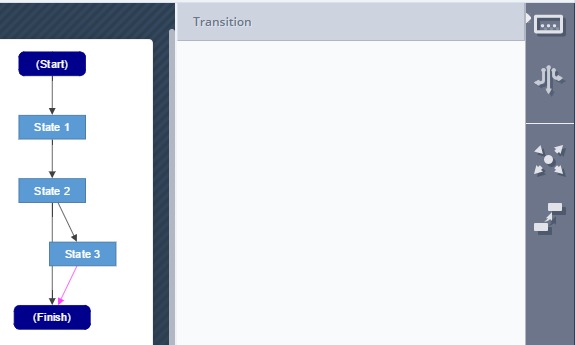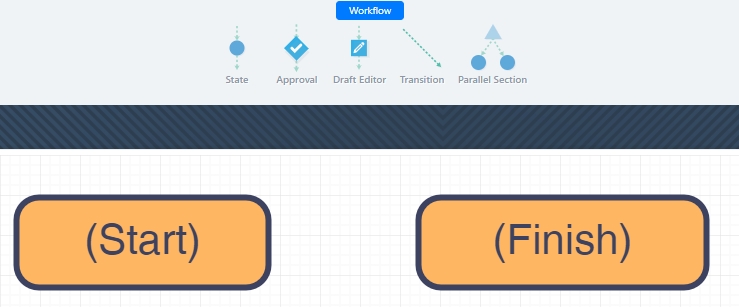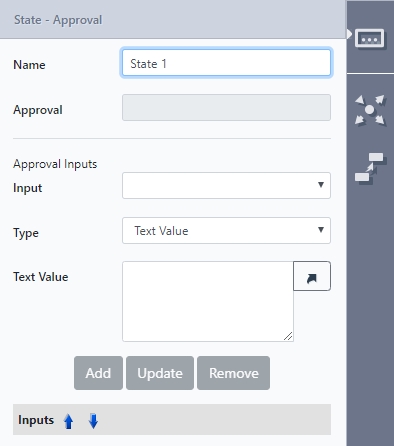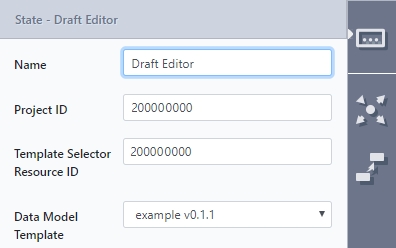Introduction
Introduction
SmartIQ Workflow allows mapping business processes where different users collaborate at a different time. To access the Workflow canvas, click this icon in the top menu.

This is the workflow canvas
States
A workflow state represents a stage or steps in the workflow process. The number of states added to a workflow will determine the number of steps the workflow may contain.

(Start) state
By default, the (Start) state will already be present in the States list. (Start) will always be the state used when first running the project in Produce. The (Start) state can be renamed but not deleted.
Approval state
The Approval workflow state is a placeholder for the form entering the approval functionality. When added to the canvas the user can select an approval from the drop-down list of available approvals. See Approvals
Draft Editor state
The Draft Editor state can be used to edit a SmartCOMM generated document based on the Project ID, Template Selector Resource ID and a selected Data Model Template. A Draft Editor state can also be added multiple times for the same document with a revised draft available for document, if this setting has been configured. See Draft Editor
Differences between state and Draft Editor state:
- Access – Normal state is part of SmartIQ and is always available with the product. The Draft Editor state can only be used if you have an equivalent SmartCOMM instance and account and if Draft Editor has been activated on that account.
- Property configuration – You can configure various settings on the normal state while the draft editor state pulls the information from the SmartCOMM templates. This is why you have to specify the name, project ID and template selector resource ID. Draft Editor uses these information to pull the specific template and configurations from SmartCOMM.
- Interface – The normal state will show question pages and/or fragments while Draft Editor will show a single page with the embedded draft editor interface.
- Temporary user – Draft Editor states cannot be assigned to Temporary users.
- Transition properties - There is an additional option to Reset Drafts for transition to Draft Editor. This option means that changes made to the document in previous Draft Editor states (if any) will be discarded and the answers from the workflow will be used for a regenerated draft. This option is default set to ON.
- Draft Generation - The initial generation of each draft is done on the transition leading onto the Draft Editor state. If subsequent draft editor states in the workflow share the same project ID and resource ID and the Reset Draft property is unchecked, the previously generated/edited draft content will be reloaded, not re-generated.
- Draft Documents – New “Draft Editor Output” documents are available for download on the finish page, action inputs or transitions that take place after draft editor states. Only a single instance will be available for each single draft.
Final State

Adding States
To add extra states to your workflow drag and drop the state question into the workflow.

Properties
State Properties
Name
By default the added state is named 'State #', however, you can rename at any point.
NoteState names must be unique.
Allow Cancellation
Allow terminating the workflow at this particular state. Following options are available:
- By Current Assignee
- By Creator
- By Previous Assignee
This option will be displayed in Produce as follows:
Due Date
Allows to define a due date for this particular state, when due date condition is met, escalations will be triggered. Here available options:
- None: No Due Date defined.
- Days After: Number of days after workflow reaches this particular state (optionally Designer can select Weekdays only).
Date: Allows to reference a question in the form to take the appropriate date (Calculated via Formula or Date Questions type.)
Approval Properties

Draft Editor Properties

- Name – Name of the state as well as the name of the generated output document of the finalised draft editor.
- Template Selector Project ID and Resource ID – These uniquely identity the document in SmartCOMMs. Logon to the SmartCOMMs cloud instance to obtain these two values. Additionally, SmartIQ uses the Project and Resource ID to identify the specific template that will be used to generate this individual draft document.
- Data Model Template – This selects the data model that will be used generating the draft document. The drop down menu will only show a list of SmartCOMM Data models that have been added onto the finish page section in Design. Any other templates will not be shown. This setup is identical to the SmartCOMM action and requires a version to be selected.
Transitions
A transition is a link between two states. Transitions will determine the flow of states.
Adding a Transition
To add a transition between two states you need to drag and drop the Transition question into the state you want to transition from (for example, (Start) state will be the first state that requires a transition).
You will now need to select which state you would like to transition to and click OK.
The transition is now added underneath the state in the 'States' view of the workflow window. It will have the same name as the state it is transitioning to.
Properties
Name
Optionally designers can specify a name of a transition.
Assignments
Defines who will receive a workflow state after a transition is done under the Send To properties for a transition.
Send To
- Creator: Selecting Creator as the Send To value will return the workflow to the user that created the workflow project. This option is not available in the (Start) state.
- Current User: Similar to Creator, selecting Current user will return the workflow to the current user that completes the workflow step.
- Previous: Similar to Creator, selecting Previous will return the workflow to the user or group who was assigned to the workflow of the state before this one. This option is not available in the (Start) state.
- User: Select from all active users in the SmartIQ system.
- Group: Select from all groups in the SmartIQ system. This will send the workflow to all active users within the group selected, however, the first user that accesses it will be the only one that can continue the workflow process.
- Temporary user
Send to Type
- Specified: Pre-assign the workflow state to an existing user or group.
- Search: Allow the user who is completing the workflow to assign the next step to a user or group.
- Question Reference: Select an existing question to define the next user or group for the workflow step.
Send to Type: Question Reference and End User experienceIf the question reference does not resolve to a user or group at runtime, the end user will not be able to submit the form. To avoid an end user landing in this position you should check the value of the question reference and transition the user to an appropriate state. This may be a separate exception handling state where administrators can resolve the issue.
Send Email
- Send Email (ON by default): This will send an email to whoever the state is assigned to.
- Email Subject: Define the subject for the email that gets sent for the transition.
- Email Body: Define the body of the email that gets sent for the transition.
The Email Subject and Email Body have defaults that are the same as what currently gets sent for Transitions.
They support Question References as well as four keyword references:
[ProjectLink]: Puts in a link to the task in Produce.
[Comments]: The comments added before submission.
[ProjectName]: Name of the Project.
[StateName]: Name of the State that has been transitioned to.
Start Page
Allows the designer to specify on which particular page the form will be loaded, especially relevant for circumstances where the first page is not appropriate.
Display Options
- Page Title: Title of the page where the user decides assignment for next state.
- Help Text: Help Text displayed on the final page where the assignment is defined by the user.
- Show Next Steps: Displays Name of next State.
- Show Comment: Includes textbox that allows the user to include comments.
- Comment Mandatory: Enforces user to provide a comment.
- Default Comment: Default comment included in comments textbox.
- Submit Button Text: Button Text.
- Submitting Text: Text displayed after for is submitted for workflow transition.
- Redirect on Finish
Redirect to Home
A checkbox is available labelled "Wait for the project to finish processing before redirect". If this box is checked, a submission and data object synchronization will take place before the user is redirected to the home page. If the box is not checked, the redirect happens immediately and the project submission will happen in the background.
Redirect to Project
Allows selecting published project to be redirected to. Note that an additional option Include Project Properties is displayed, allowing to specify project property values.
Redirect to Url
Allows specifying to which URL the project will be redirected. Note that this can be a reference or hardcoded value.
All options have Online Message on Redirect property.
Redirect on Finish
Downloads
Allows the designer to specify documents to be available to be downloaded when the transition is triggered.
Transition to Draft Editor stateDownload is replaced with Generate for the Draft Editor state and the initial generation of each draft is done on the transition leading onto the Draft Editor state. If subsequent draft editor states in the workflow share the same project ID and resource ID and the Reset Draft property is unchecked, the previously generated/edited draft content will be reloaded, not re-generated.
Transition Conditions
In some cases, a state may have multiple transitions to other states. For example, if the workflow is an approval process and the workflow is approved it will go to one state, and if the approver doesn't approve it may go to another state. This can be defined within the transition conditions.
Transition conditions work the same as all other conditions within SmartIQ however, the only available condition type is Answer Value.

Adding Actions to workflow transitions
Actions can be added to transitions in a workflow.
- Open the workflow canvas in Design.
- Select the workflow transition where one or more Action needs to occur.
- Click on the Actions Button located on the right side menu.
- The Actions list will pop up.
- Drag and drop the action(s) you would like to add to the transition.
NoteAction Properties are displayed when you select the desired Action.
Reordering actions
In the web designer, on the workflow page, where we show a graphical representation of the workflow, users now have the ability to reorder the workflow actions just like the finish page actions.
Note:Actions can be reordered only within the same transition and NOT across transitions, as that would be MOVE and not REORDER
The reordering can be done in two ways:
-
Grab the action which needs to be reordered and drop it on any other action in the same transition, this will result in the grabbed action to appear before the action on which it is being dropped.
-
Grab the action which needs to be reordered and drop it on any transition(arrows between two actions or between the first/last state and an action), this will simply result in the action to appear where it was intended.
Executing one of the above will enable the SAVE button, and you can then either confirm or cancel changes.
Updated 5 months ago
